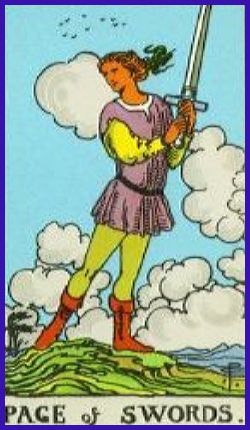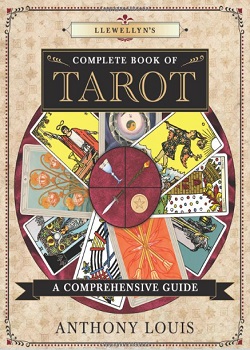Your Chosen Card – Page of Swords Upright Rider Waite Deck

Pages represent children or young people, new learning experiences, the beginning stages of things, and messages coming to the querent. When upright, the Page of Swords is a perceptive young person who quickly connects the dots to construct theories about what is happening. His ability to plan mentally and to cut to the chase makes this Page especially adept at any type of work requiring secrecy, discernment and keen mental planning. He would be a formidable opponent in a game of chess. This page values his ability to think independently, but sometimes his sharp words or abrupt manner of communication are experienced as hurtful by those around him. Sometimes this card appears when one is dealing with unwanted news or upsetting messages.
Keywords Upright: intelligent, alert, lithe, curious, perceptive, vigilant, secretive, subtle, clever with words, discreet, observant, independent, good at keeping secrets, analytical, strategic, quick thinking, resolute, easily connects the dots; unexpected or astonishing news, a remark or opinion, a spy, a keen observer, analysis, clarity, secret service, mental planning.
Decans/Timing: Astrology associates the element Air with autumn.
Astrology: Earth of Air. The Pages (Princesses) have no zodiacal attribution but represent four types of ‘elemental’ people.
Rider Waite: A lithe, active figure holds a sword upright in both hands, while in the act of swift walking. He is passing over rugged land, and about his way the clouds are collocated wildly. He is alert and lithe, looking this way and that, as if an expected enemy might appear at any moment. Divinatory Meanings: Authority, overseeing, secret service, vigilance, spying, examination, and the qualities thereto belonging; (R) the more evil side of these qualities; what is unforeseen, unprepared state; sickness is also intimated.
When Page of Swords is upright you can pretty much take it that life is going well but that’s when life takes us by surprise. If Page of Swords is unclear it may help to choose a card from the Major Arcana to provide more insight into what it is Page of Swords is trying to tell you. If you had a particular issue in mind, or want to seek clarification on something else, you can also choose again to get more guidance.

This chosen card is part of your upright card reading for Page of Swords using cards from the Rider Waite Tarot Deck. You will find many more tarot pages that will be of great help if you need tarot card meanings. Use the search at the bottom of the page. We have some amazing tarot books for you to browse. Please see below.
Here are some snippets from a few of my favorite books

Book Details
Creative Tarot: Which is, essentially, what the imagery of the tarot does as well. Every gesture, every color, every archetype and figure stands in for something greater, something very personal and meaningful to us. Its no wonder, then, that surrealists were drawn to the tarot.
Complete Book of Tarot: The Tarot of Marseille, the oldest known of which is by Jean Noblet in Paris around 1650.
- Do get in touch if you looked for Page of Swords and we don’t have it listed. We would be more than happy to source the information for you. We hope you visit again for more online tarot information!
Tarot Triumphs: There is not one single ‘true’ Tarot pack because of the variations in traditional designs of the Triumphs and the branching lines of transmission into different countries and cultures. This may indeed be a good thing; the Tarot’s own ‘triumph’ is that the archetypal images on the cards are so strong that the actual designs can take a modicum of variation and still retain their magnetism. Anything genuinely mythical has the capacity to appear in a range of representations: there are many differing images of the Holy Grail or the Green Man, for instance. A good divinatory system has room for adaptation; one where every detail is legislated quickly becomes dated and rigid.2 It is fascinating to compare these differing Tarot designs and to pick out variations in detail, but more as a way of enhancing our understanding and confirming the real essence of the card, rather than pointing the way to a ‘correct’ version of Tarot.